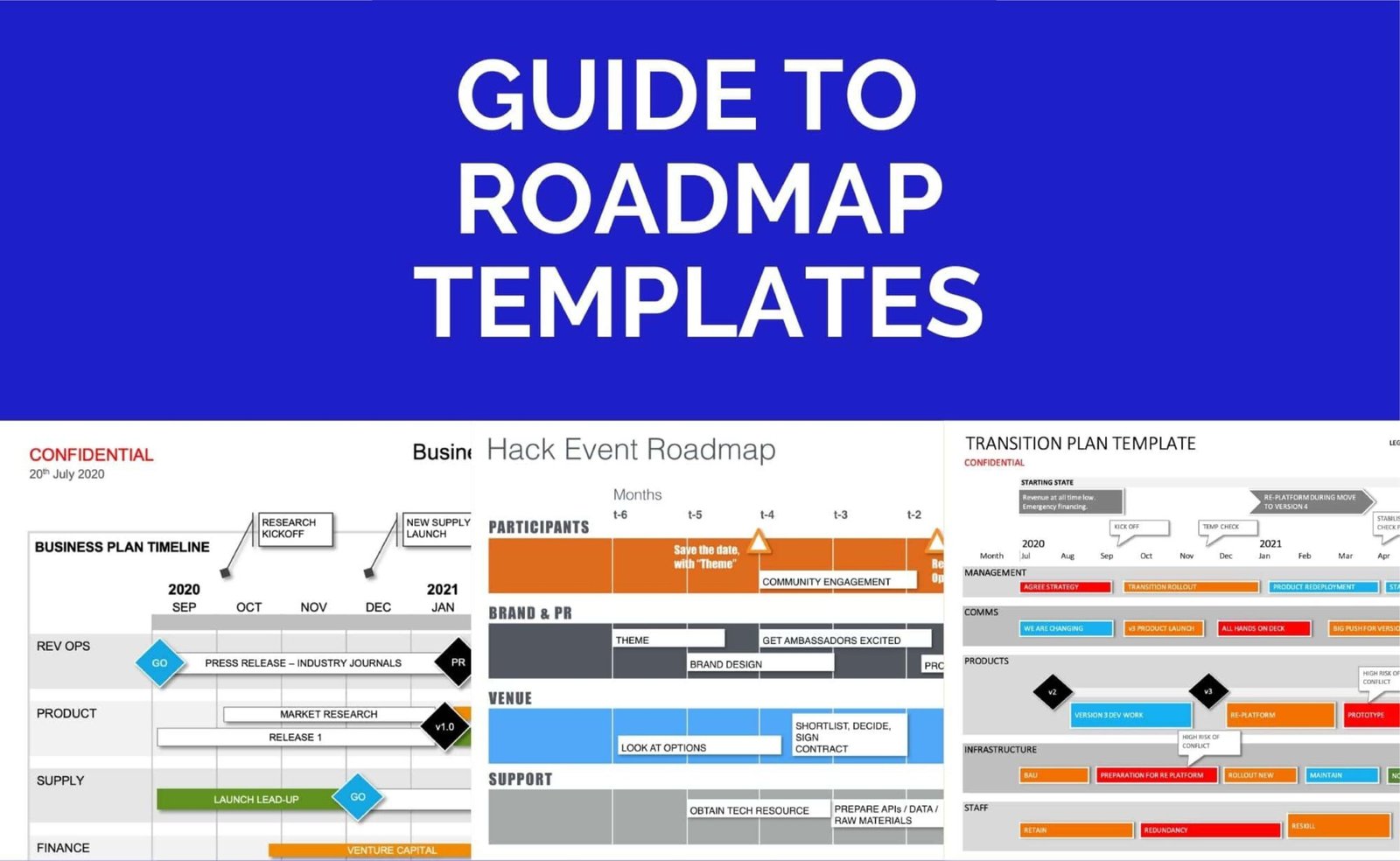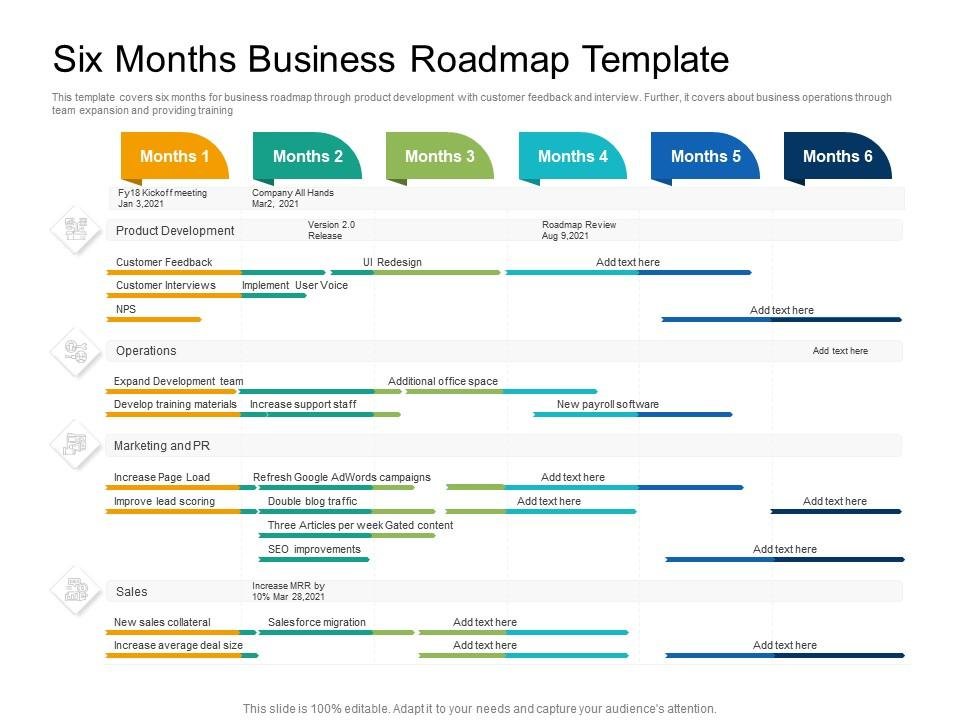What are Business Roadmap Templates?
These templates are strategic planning tools that outline the key milestones and deliverables of a project. They provide a visual timeline that helps teams understand the sequence of tasks and the dependencies between them. These templates can cover various types of roadmaps, including product, marketing, technology, and organizational development. By using a standardized template, businesses can ensure consistency and clarity in their project planning.

Related Article: Project Portfolio Tracker Template
Key Components of Business Roadmap Template
- Objectives and Goals: Every Business Roadmap Template starts with clear objectives and goals. These define the purpose of the project and the desired outcomes. Setting specific, measurable, achievable, relevant, and time-bound (SMART) goals helps ensure the project’s success.
- Milestones: Milestones are critical points in the project timeline that signify major achievements or deliverables. They help track progress and ensure that the project stays on schedule. Milestones provide a sense of accomplishment and motivation for the team.
- Timeline: The timeline is a crucial element of any Business Roadmap Template. It provides a visual representation of the project’s duration, including start and end dates for each task and milestone. A well-defined timeline helps manage expectations and ensures that the project remains on track.
- Tasks and Activities: Detailed tasks and activities are listed to break down the project into manageable steps. Each task should have a clear description, assigned resources, and a deadline. This ensures that everyone understands their responsibilities and can work efficiently.
- Dependencies: Dependencies illustrate the relationships between tasks. They show which tasks must be completed before others can begin. Understanding dependencies helps identify potential bottlenecks and allows for better resource allocation.
- Resources: A comprehensive Business Roadmap Template includes a list of required resources, such as personnel, equipment, and budget. Proper resource planning ensures that the project has everything it needs to proceed without interruptions.
- Stakeholders: Identifying key stakeholders and their roles is essential for successful project management. Stakeholders can include team members, project sponsors, customers, and other relevant parties. Understanding stakeholder expectations and maintaining open communication is crucial for project success.
- Risk Management: Risk management involves identifying potential risks and developing strategies to mitigate them. A robust Business Roadmap Template includes a risk management plan to address uncertainties and ensure the project remains on course.
- Performance Metrics: Tracking performance metrics helps measure the project’s progress and success. Metrics can include key performance indicators (KPIs), such as budget adherence, timeline compliance, and quality standards. Regularly reviewing these metrics allows for timely adjustments and continuous improvement.
- Review and Adaptation: A successful Business Roadmap Template incorporates regular review and adaptation processes. This ensures that the project remains aligned with changing business needs and external factors. Flexibility and adaptability are key to maintaining project relevance and effectiveness.
Related Article: Stakeholder Matrix Template

Role in Project Management
These Business Roadmap Templates play a vital role in project management by providing a structured approach to planning and execution. They help ensure that all team members understand the project’s goals, timelines, and tasks. This alignment is critical for achieving project success. Here are some keyways in which these templates contribute to effective project management:
Clarity and Communication: These templates provide a clear and concise way to communicate the project’s plan to all stakeholders. This helps ensure that everyone is on the same page and working towards the same goals. Clear communication reduces misunderstandings and improves collaboration.
Alignment and Focus: By outlining the project’s objectives, milestones, and tasks, these templates help teams stay focused on their priorities. This alignment ensures that resources are used efficiently and that the project remains on track.
Resource Management: Effective resource management is crucial for project success. This template help identify the necessary resources and allocate them appropriately. This prevents resource shortages and ensures that the project has the support it needs to succeed.
Risk Management: Identifying potential risks and developing mitigation strategies is a key aspect of project management. Business Roadmap Templates include risk management plans that help teams anticipate and address challenges before they become critical issues.
Related Article: Inventory Management Templates
Performance Tracking: Tracking progress against the roadmap’s milestones and performance metrics allows for timely adjustments. This helps ensure that the project stays on schedule and meets its objectives. Regular performance reviews provide opportunities for continuous improvement.
Stakeholder Engagement: Engaging stakeholders throughout the project lifecycle is essential for success. This Template helps identify key stakeholders and outline their roles and responsibilities. This ensures that stakeholders remain informed and engaged, leading to better decision-making and support.
Flexibility and Adaptability: Projects often encounter changes in scope, resources, or external factors. These templates provide a structured approach to reviewing and adapting the project plan. This flexibility helps maintain project relevance and effectiveness in a dynamic environment.
Related Article: Project Schedule Template
Best Practices for Using Business Roadmap Template
To maximize the effectiveness of Business Roadmap Template, businesses should follow best practices. These practices ensure that the templates are used correctly and provide the desired outcomes. Here are some best practices for using these templates:
- Define Clear Objectives: Start with clear objectives and goals for the project. This ensures that the roadmap aligns with business needs and provides a clear direction.
- Engage Stakeholders: Involve key stakeholders in the planning process. This ensures that their input and expectations are considered and increases their commitment to the project.
- Use Visuals: Utilize visual elements, such as charts and graphs, to make the roadmap easy to understand. Visuals help communicate complex information and enhance stakeholder engagement.
- Keep it Simple: Avoid overcomplicating the roadmap with excessive details. Focus on the key milestones, tasks, and dependencies. A simple and clear roadmap is more effective and easier to follow.
- Regularly Review and Update: Conduct regular reviews of the roadmap to ensure that it remains relevant and accurate. Update the roadmap as needed to reflect changes in the project scope, resources, or external factors.
- Communicate Effectively: Use the roadmap as a communication tool to keep stakeholders informed. Regularly share updates and progress reports to maintain transparency and build trust.
- Monitor Performance: Track performance metrics and milestones to ensure that the project stays on track. Use these metrics to identify areas for improvement and make necessary adjustments.
- Be Flexible: Maintain flexibility in the project plan to adapt to changes. A flexible roadmap allows for adjustments and helps the project remain effective in a dynamic environment.
Related Article: business plan
Conclusion
Business Roadmap Templates serve as essential tools in project management. They provide a structured approach to planning and executing projects, ensuring that teams remain aligned and focused on their objectives. By outlining clear goals, milestones, and tasks, these templates help manage resources, mitigate risks, and track performance. Businesses that utilize these templates can achieve better project outcomes and drive organizational success. To maximize their effectiveness, it is crucial to define clear objectives, engage stakeholders, use visuals, keep the roadmap simple, regularly review and update it, communicate effectively, monitor performance, and maintain flexibility. By following these best practices, businesses can leverage business roadmap template to navigate their projects successfully and achieve their strategic goals.


